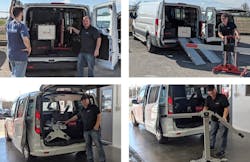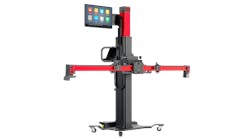David Krause spent a lot of time throughout his 30-year automotive career waiting for the industry to catch up. Krause, a fourth-generation electrical technician, owns Platinum Programming and Diagnostics in Houston and Nashville, Tenn., a mobile business that travels to collision repair and glass shops to diagnose vehicles, program modules and, for close to two years, calibrate the cameras and radar devices used by advanced driver-assistance systems (ADAS).
Throughout the years, Krause has sounded the repair battle cry on the importance of doing things the right way and patiently waited until his customer shops and the supporting industries at large acquiesced and did so. First, it was integrated, multi-systems diagnostics; then pre- and post-repair scanning; now it’s ADAS. Or, more specifically, the critical importance of calibrating these safety systems’ cameras and radar units. He says he’s passionate about his work, though, when it comes to ADAS, he’s less patient than before, because he knows the stakes are high.
Proper Calibrations Save Comebacks
He describes going to a collision repair shop to replace a wiring harness and provide a pre- and post-repair scan on a Honda Civic. After the repair was completed, Krause advised the shop owner the radar needed to be re-calibrated. The owner disagreed, stating it wasn’t damaged, so it didn’t need a calibration. Krause was instructed to run a post-scan and call it a day.
He relented and ran the scan, adding a disclaimer to his report that a calibration was advised but not completed. As the radar unit was functioning, the scan showed no codes. The customer retrieved his vehicle and drove away. The driver entered an intersection with the intention of turning left. The misaligned radar unit detected something in front of the vehicle and the ADAS instructed the vehicle to stop. It did—in the middle of the intersection. The vehicle was hit on both sides. After that, never again did the shop manager balk at a calibration Krause advised.
Any sensor needs to be calibrated if repairs have been made and confirmed in a report that the vehicle had no codes beforehand. Only recently has it become acceptable to complete radar-based calibrations outside because light does not affect the accuracy of the radar sensor calibration.
Krause wasn’t content waiting for the right ADAS equipment to be made. As an Autel diagnostic scan tool user since the debut of its MaxiSYS 908 Pro tablet in 2014, he reached out and suggested to the company to add ADAS calibration tools and targets to its product line.
Little did he know, however, that Autel was already developing an ADAS calibration system to integrate into all the MaxiSYS tablets. In 2018, Autel released a comprehensive system including software, frame, patterns and targets.
Krause says, “We went all in. Everything Autel had, we bought.”
In addition to the camera targets, patterns, and radar reflectors and calibrators for multiple vehicle lines, Autel’s first-generation ADAS calibration system includes a substantial frame with a steel base, durable enough for his multi-location use. Krause says his business has thrived with the first-generation system. He knows the 160-pound frame and nearly 9-foot-long crossbar were not designed for mobile use, but the system became extremely dependable after completing so many calibrations without issue. In fact, Krause had to purchase a larger Ford T150 transit van to be able to move it to his customers’ shops.
“My guys are fit, and we made it work. We knew nobody else in the market had what we had,” he says.
Yet, it would be no surprise when Autel later released its portable ADAS calibration system, the MA600, with a foldable crossbar and modular frame parts which weighed less than half of the first frame, that easily separated for faster transport and setup. By this time, Platinum’s team of 11 technicians were all smiles, understanding that their business was becoming more widely accepted and supported.
Though each Autel ADAS calibration system centers and squares the frame with the vehicle differently, the essence of the calibration process is the same. With the addition of its new and ever-expanding list of available patterns, targets and tools, both frame options can calibrate a wide range of radar and camera vehicle systems such as Ford, General Motors, Subaru, Mercedes Benz, BMW, Porsche, Toyota, Honda, Mazda, Volkswagen, KIA and Mitsubishi.
Calibration is Critical, Profitable and Increasingly Prevalent
Krause continues to search for new glass-focused repair and replacement shops that need his help to keep their customers safe. Krause says many glass-focused shops are ill-informed about the necessity of camera calibration after windshield replacement and feel the effect on their bottom lines, as calibrations add to service time and reduce the number of windshields they can replace in a day. The reality, however, is the opposite—glass repair shops need to understand how important their businesses are to the repair industry for the years to come and how their local repair shops and even dealers will want to use their help to complete difficult projects.
“Every windshield is made and installed differently. Every mount is different, even space gaps are all different,” he says.
“It’s a constant education. We go to the shop and tell them what we need to do. But everyone is focused on the DTC scanning, especially with ADAS. They think if there’s no code, then the vehicle is good to release to the customer. But that’s not how the camera and radar-based systems work. Their customer safety is on the line because of their misunderstanding and lives are being put in danger.”
Convincing shops to look beyond the DTC to understand how to complete the repair honorably will always be the industry focus. Now that the insurance carriers have understood and adopted the needed cost of pre-repair scanning and post-repair scanning to the repair process, the same crusade is being fought over the ADAS calibration process. The acceptable calibration cost by the insurance carrier varies on the vehicle make and model as well as the system being calibrated, so this crusade will continue until an industry-wide understanding of the needed ADAS calibration is accepted.




